On the Farm
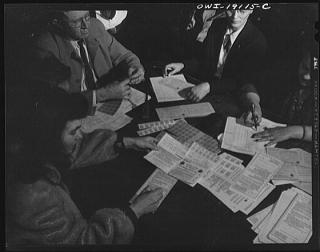
Signing up for sugar and food rationing in 1943
Food supplies became a major concern for the United States at home and abroad during World War II. Under the Lend-Lease Program, the United States helped supply food to its allies in Europe and the Pacific. To support the needs of the American home front, the US government began food rationing in 1942. The first item rationed was sugar, followed by foods including: butter, milk, and meat. The government began to grow more food to support the home front, troops, and allies. However, many men left the farms to join the military, so more workers were needed in agriculture to produce the additional food required during the war.
In order to reverse the labor shortage, the American and Mexican governments signed the Mexican Farm Labor Agreement in August 1942. The agreement created the Bracero Program which sought to bring Mexican workers to the US to fulfil agricultural labor needs.
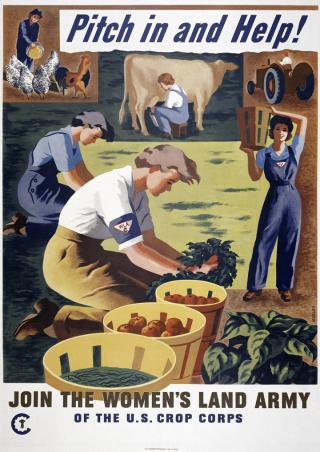
Poster from World War II
In that same year, Eleanor Roosevelt toured Britain and saw the work that women were carrying out on farms in the Women’s Land Army to help with the food situation. When she returned to the United States, Roosevelt, as assistant director of the Office of Civilian Defense, began advocating for the use of women in agriculture. However, the United States Department of Agriculture (USDA) rejected the idea of women working on farms. Government officials and many people on the home front did not believe that women had the skills or strength to carry out such work.
Labor shortages continued to slow agricultural output, so the government changed its views on employing women on American farms. In April 1943, Congress passed legislation to create the Emergency Farm Labor Program. This program allowed a variety of groups to work the land, including prisoners of war from Italy and Germany, people from the Caribbean, students, and women.
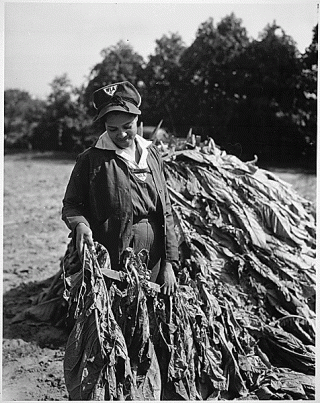
Mrs. Sam Crawford helps with tobacco harvesting while wearing the Women's Land Army uniform.
The Women’s Land Army of America, later known as the Women’s Land Army (WLA), employed women throughout the country on local farms. The WLA was in operation from 1943 to 1945. Florence L. Hall, a senior home economist with the USDA Extension Service, was the director of the WLA. The system was administered by the United States Crop Corps, but it was organized by state and local authorities and Extension Services. These organizations worked together to recruit and provide training to women for the WLA. Many women, however, did not receive formal training. They learned on the job.
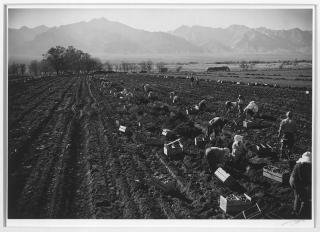
Potato Fields at Manzanar Relocation Center
The time that women worked on the farms varied. They could spend one to two weeks during their vacation period, help during the summer or harvest periods, or spend the entire year working for the WLA. The majority of women were employed seasonally on farms. It is estimated that 2.5 million women participated in the program and helped to feed the nation and her Allies.
Japanese Americans also helped on the farms. During the war, agricultural companies needed workers to replace those who left to join the military or took other wartime employment. To fill this need, companies and the US government turned to Japanese Americans imprisoned in internment camps. The Japanese Americans were asked to work on farms and at agricultural processing plants. Seabrook Farms was one of the companies that sought assistance from the Japanese American community to process produce at its factory in New Jersey. In total, approximately 26,000 Japanese Americans worked in agriculture during the war.
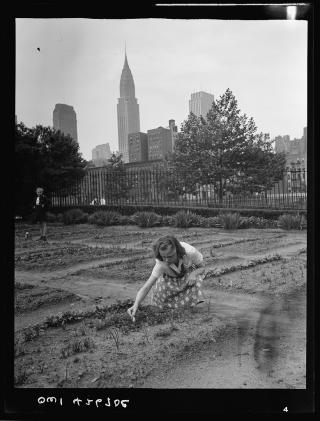
Children's School Victory Gardens in New York City
Victory gardens were also vital to the home front. The government encouraged ordinary citizens to grow fruits and vegetables in their backyards, community parks, and playing fields to provide extra food during the conflict. Many people were eager to contribute to the war effort in this way. The USDA estimates that by 1943, 20 million gardens had been planted throughout the United States, producing 10 billion pounds of food.
By Dr. Kelly A. Spring
2017
Discussion Questions:
- Who were the different types of workers on the farms?
- What role did Mexicans and Japanese Americans have on U.S. farms during the war?
- Why was it important for women to fill new roles on American farms?
- Why did some people object to women working in agriculture?
- How did victory gardens contribute to the food grown in the United States during the war?
Works Cited:
Articles
- Carpenter, Stephanie Ann. “‘Regular Farm Girl’: The Women’s Land Army I World War II.” Agricultural History 71 (1997): 162-185.
- Litoff, Judy Barrett, and David C. Smith. “To the Rescue of the Crops.” Prologue 25 (1993): 1-25. Accessed July 14, 2017. https://www.archives.gov/publications/prologue/1993/winter/landarmy.html
Books
- Gamboa, Erasmo. Mexican labor and World War II: Braceros in the Pacific Northwest, 1942-1947 Austin: University of Texas Press, 1990.
- Gowdy-Wygant, Cecilia. Cultivating Victory: The Women’s Land Army and the Victory Garden Movement Pittsburgh: University of Pittsburgh Press, 2013.
Newspaper
- Deignan, Tom. “Held in WWII Internment Camps, One Group of Japanese-Americans Found an Escape in South Jersey.” The Star-Ledger, June 20, 2015. Accessed July 17, 2017. http://www.nj.com/opinion/index.ssf/2015/
06held_in_wwii_internment_camps_one_group_of_japanes.html
Online Exhibition
- National Museum of American History – Smithsonian Institute. “Righting a Wrong: Japanese Americans and World War II.” Accessed July 19, 2017. http://americanhistory.si.edu/righting-wrong-japanese-americans-and-world-war-ii
